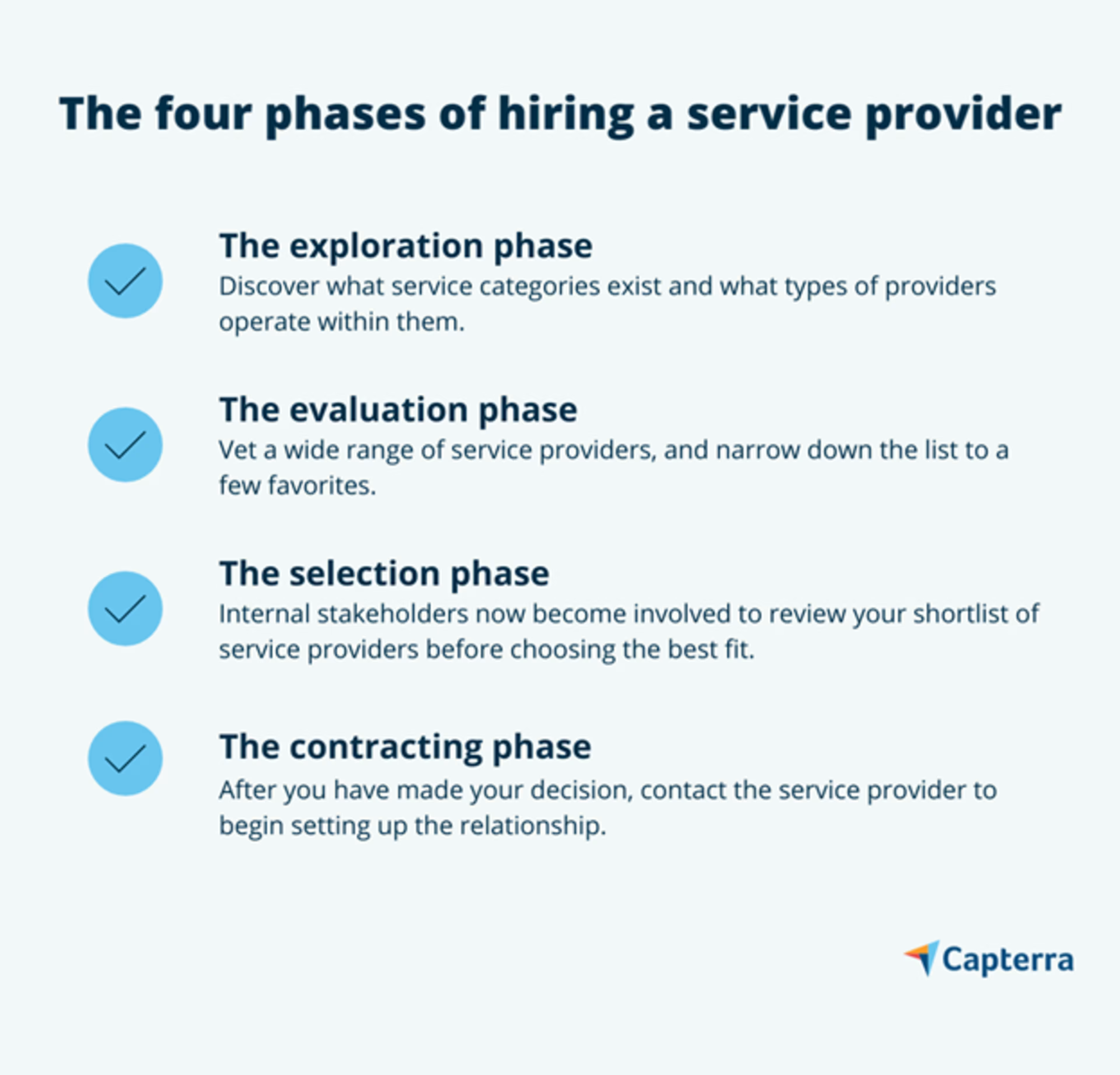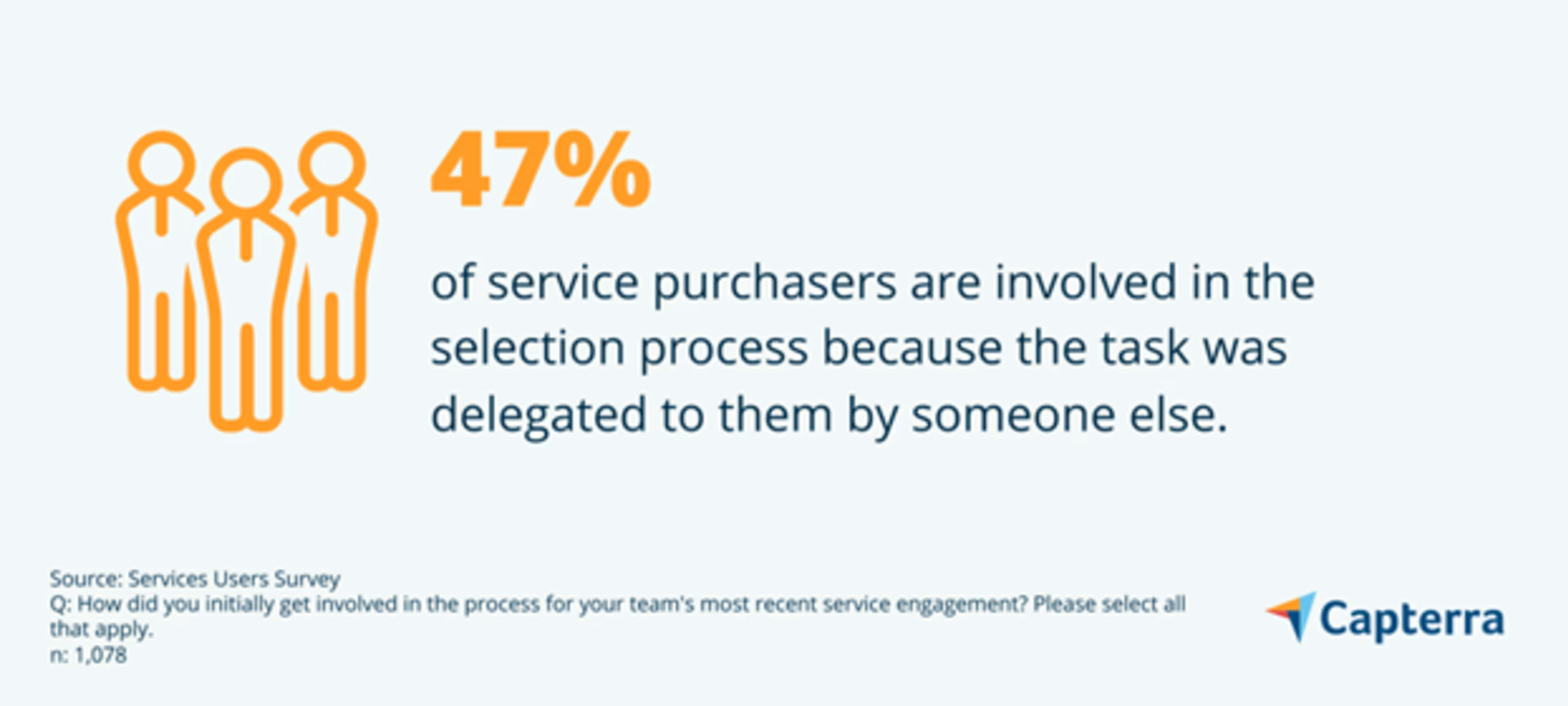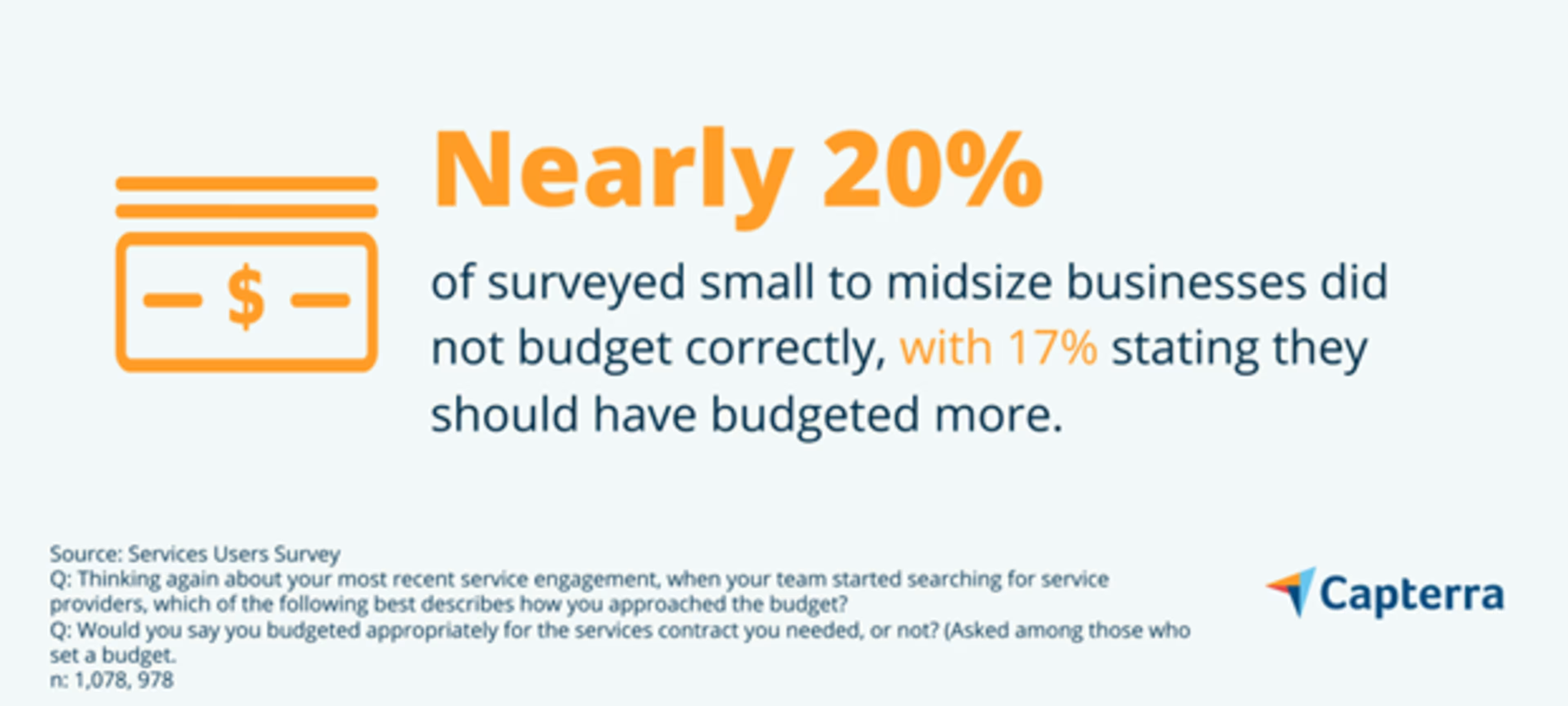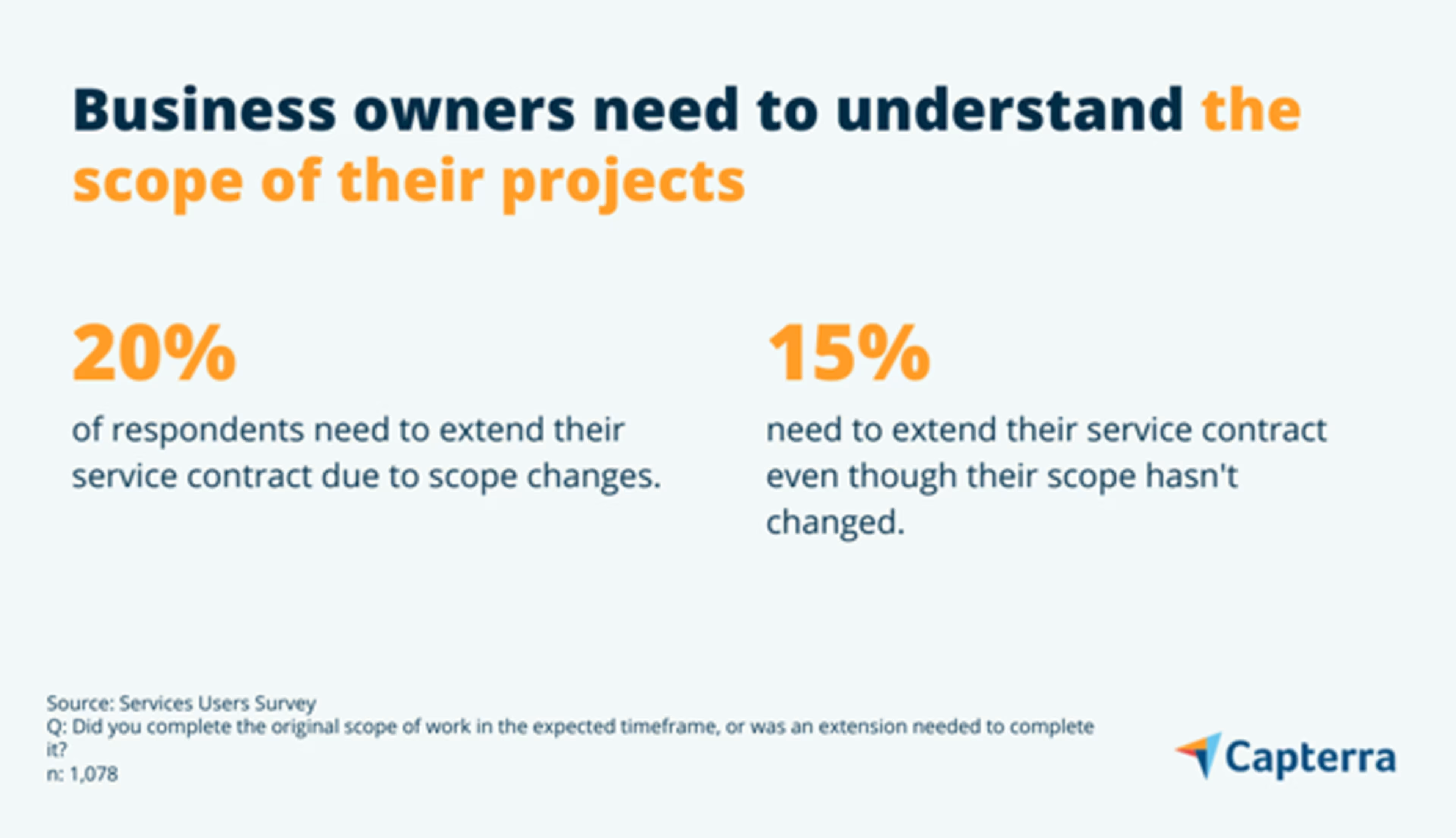Provide your business with extra bandwidth and expertise without spending unnecessary time and money to do so.
As a small-business owner preparing to undergo the process of hiring a service provider for the first time, you want to make sure that the provider you choose will help you achieve all of the specific needs and business goals you need to succeed.
Often, it can take just as much time to find a provider as it does for the provider to complete their contract, but with due diligence, you won’t risk hiring the wrong fit and wasting even more time and revenue to fix costly mistakes. You might even build long-lasting relationships with providers that can help skyrocket your business growth due to the increased bandwidth and efficiency you’ve derived from delegating.
If you aren’t sure about what pitfalls exist when searching for service providers, don’t worry; we’re here to help you. We’ll guide you through this process with insights from Capterra’s 2022 Services Users Survey [*] which will help you understand what it takes to find the right provider and avoid potential snags along the way.
What can I expect from an effective service provider?
Hiring an objective third-party provider that is helping you work toward your business critical objectives can be worth every penny for a growing business. Here’s some of the primary ways a service provider can help:
Time and money savings: You can avoid mistakes, optimize processes, and strengthen long-term strategies which will save you time and money.
Access to outside expertise: You have to wear a lot of hats as a business owner, which means it’s unlikely you’ll become an expert at all the things you have to do. Service providers bring expertise to the table that you or your employees may not have.
Help with daily tasks: Analyzing data, planning for future campaigns (marketing, SEO, recruitment, etc.), and managing those campaigns takes a ton of time and energy. Hiring a service provider helps delegate some of that responsibility so you can be more productive and effective.
Objective input on your business’s trajectory: Sometimes it’s just good to have someone from the outside take a look at your internal processes and strategy. Professional service providers and agencies can offer fresh perspectives on your decisions and strategy which will help you scale your business more effectively.
For more info on common types of service providers, visit the Capterra glossary:
What are the phases of hiring a service provider?
There are four distinct phases to the service provider hiring process. Here they are with a brief overview of what each phase includes:

Once you have a handle on what the general process for selecting a service provider looks like, you’re ready to begin your search in earnest. But before you do, we’ll make you aware of the common pitfalls to avoid.
Pitfall #1: Assuming all stakeholders are on the same page about what you're looking for in a service provider
As a small-business owner, you know that while you can do a lot of things by yourself, you often need to trust and rely on the team you’ve built around you. The decision-making process for hiring a service provider should be no different. One of the major pitfalls is that the wrong service provider is often chosen if the servicer purchaser is given the task without support or communication.

What does this mean for my business?
An easy way to select a service provider that falls short of your expectations is a lack of communication between those who determine the need for a provider and the ones who ultimately make the choice and the purchase. Ensure that everyone on the selection committee is fully briefed on the expectations, goals, and projected outcomes of your work with a service provider before they even begin their search.
Here are some steps for setting up a service-provider selection committee so that everyone is on the same page:
Determine what business challenges you need the service provider to address.
Pick one to three people at your business who have, at the very least, a general expertise with that challenge.
Hold kickoff meetings where you determine scope, scale, and expectations for the service provider.
Have regular check-ins with the service-provider selection committee in order to field any questions, concerns, or problems that they might be encountering during the selection process.
If you are intentional and deliberate about delegating the selection process, you’ll set yourself up better in the long run by having more committed team members who are aware of the needs a service provider will address. And therefore, you're more likely to have a service provider who is a better fit for your business.
Pitfall #2: Budgeting mishaps brought on by hidden costs and misunderstanding of the range of projected services
Digital service agencies can have a wide range of pricing models that depend on various factors such as project timeline, the type of service and expertise required, and scope of work.
Here’s a few pricing models that you might encounter in your search:
Project-based or fixed-fee model: You’ll most likely find these pricing models from full-service digital agencies that work on long-term projects and cover end-to-end marketing and promotion services (from strategy and consultation to campaign tracking). Typically, you can expect them to quote the estimated cost of the entire project upfront as well as an upfront fee (usually 15% to 20% of the entire project cost) before starting the project.
Hourly pricing model: As you might expect from the name, agencies who use this pricing model will charge a specific amount for every hour of work. The hourly rate may change depending on the experience of the specialists you hire, or the type of service you require. For instance, ideating on product innovation might cost more or less than working on media planning.
Monthly pricing model: Many full-service agencies follow a monthly rate pricing model. Like you might expect, they charge monthly for their services, and it’s usually a flat rate. The pricing can vary depending on the type of service you require just like the hourly pricing model.

What does this mean for my business?
You’ll want to determine what type of pricing is the best fit for your current project early on. Some work such as planning and tracking entire marketing campaigns might need to be project-based while some SEO optimization assistance might be charged via an hourly or monthly rate. Having a clear understanding of the scope and scale of your project before you start vetting vendors will help you set the correct budget to keep you from spending too much or too little.
When talking about project scope with your potential service provider, make sure to get the lowest and highest estimate ranges of their projected services. If your budget is tight and allocating more money to this effort is not possible, make that explicitly clear.
Pitfall #3: Spending more money on extending your service contract because of unclear goals and expectations.
This is where having a service-provider selection committee will come in handy. If you don’t know exactly what project or tasks you need help with, you’re likely to spend more money when hiring a provider. Perhaps you underestimated the scope and scale and have to hire them for an extended period of time to complete the project, or you overestimated the scope and scale so you’re paying for more than you need.

What does this mean for my business?
With 35% of respondents needing to extend the runway for their service contracts [*], you may need to prepare for the contingency that work might take longer than you originally thought—especially if the work the service provider is doing is not yet well-defined.
To mitigate against this risk, ensure that you have priorities established for this project and that you've clearly communicated your timelines with the service provider. Establishing regular check-ins on the work they’re doing will also help you identify where there may be a risk of scope creep.
These check-ins can include going over key metrics data to determine if the goals of the project are being tackled effectively. Remember though, it’s a partnership and a relationship. The key is to set up consistent evaluations and check-ins in order to make sure expectations are being met, not to micromanage. You hired them because they are experts.
Get the most out of your service provider relationship with these Capterra tools and tips
Now that you know what to look out for, as well as what to avoid, you’re set up to hire the best service provider possible that can help you boost sales, improve SEO, or increase marketing revenue.
The work doesn’t stop with the hiring though. You’ll want to make sure you’re setting your new partner up for success when they integrate with your business. You’ll need to acquaint them with the processes, tools, and technology that you use on a daily basis.
What technology you give them access to is dependent upon the types of tasks you hired them to help handle, but in nearly all cases, they will need access to some of your tools to help integrate their findings and work into your business.
Some of the more common technology you may grant a service provider access to include tools such as:
Generally, these tools will include safety measures such as user-based account access to help provide service providers access without giving them the ability to see your confidential information.
When service providers gain access to the relevant tools, they not only help with important tasks, but they’ll also be able to help optimize your tools for the types of work you hired them to do. Collaborating in this way often yields short- and long-term effects for your business such as increased efficiency and productivity. You might even learn a thing or two about how to best utilize features that you hadn’t considered before.
For more information on the process of choosing and hiring a service provider, make sure to visit the Capterra blog where we host a wealth of resources, including pieces such as:
